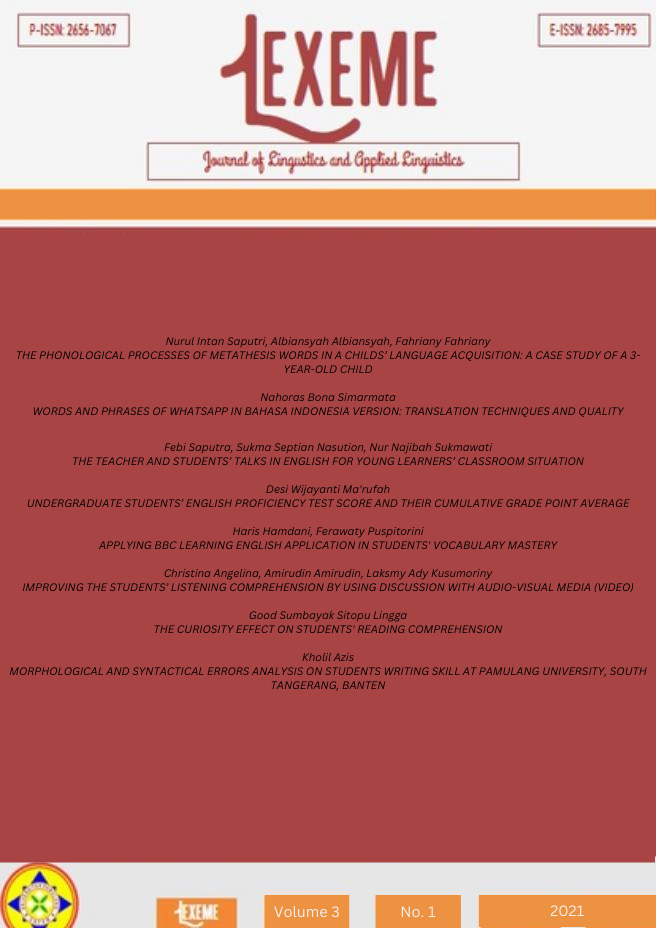MORPHOLOGICAL AND SYNTACTICAL ERRORS ANALYSIS ON STUDENTS WRITING SKILL AT PAMULANG UNIVERSITY, SOUTH TANGERANG, BANTEN
DOI:
https://doi.org/10.32493/ljlal.v3i1.15711Keywords:
Morphology, Syntax, Errors Analysis, Students CompositionAbstract
The aim of this research is to find out the Morphological and Syntactical errors made by the students in their written texts, the number of errors, and the types of errors that most often appear. The method which is used in this research is descriptive method. Descriptive research method refers to the method used to describe the data and the characteristics used to describe the population. The purpose of using the descriptive method is to obtain systematic, factual and accurate data that can provide an actual picture of the data that is the research material. Descriptive research methods should not be used in making causal relationships where one variable affects other variables. The source of the data was taken from the writings of 10 first semester students of the Faculty of Letters, Pamulang University, South Tangerang, Banten. In collecting data, the students were asked to write an essay in English. Students are given the freedom of topics to be written. In conclusion, from the 69 errors identified, there were 13 errors in the Morphological category and there were 56 errors in the Syntactical category from the total data found. From these results, it can be concluded that students make greater mistakes in the Syntactical category.
References
Aitchison, J. 1995. Linguistics: an introduction. Great Britain: Hodder & Stoughton Educational.
Azar, B, S. 1993. Fundamentals of English grammar edisi inggris – indonesia. Jakarta: Binarupa Aksara.
Brown, H, D. 1994. Teaching by principles: interactive language teaching methodology. New York: Prentice Hall Regents.
Brown, H, D. 2003. Language assessment principles and classroom practices. USA: Longman.
Brown, H. D. 1993. Principles of language learning and teaching third edition. Englewood Cliffs, New Jersey: Prentice Hall Regents.
Brown, H. D. 2003. Principles of language learning and teaching third edition. New York: Longman.
Brown, J, D.. 1998. New ways of classroom assessment. Alexandria: VA.
Burt, M. K., & Dulay, H, C. 1977. English as a second language. New York: Regents Publishing Company.
Carstairs-McCarthy, A. 1992. Current morphology. New York: Routledge.
Chaer, A. 2007) Linguistik Umum. Jakarta: Rineka Cipta.
Corder, S. Pit. 1967. The Significance of learners’ errors. Reprinted in Richard, Jack (ed) 1974, 1984 (p. 19-27). Error analysis: perspectives on second language acquisition. London: Longman.
Corder, S. P. 1981. Error analysis and interlanguage. New York: Oxpord University Press.
Dulay, H, B, K. 1982. Language two. New York: Oxford University Press.
Erdogan, V. 2005. Contribution of error analysis to foreign language teaching. Mersin University Journal of the Faculty of Education. 1(2), 261-270.
Fauziati, E. 2005. Introduction to methods and approaches in second or foreignlanguageteaching. Surakarta: Muhammadiyah University Press
Frank, M. 1972. Modern English exercises for nonnative speakers Part 1: parts of speech. Englewoods Cliffs, New Jersey: Prentice Hall.
Fromkin, V. & Rober, R. 1998. An introduction to language. California: Harcourt Brace College Publisher.
Gunawan, A, H. 2010. Sosiologi pendidikan. Jakarta: Rineka Cipta.
Harmer, J. 2004. How to teach writing. Essex: Pearson dcation Limited.
Harmer, J. 2007. How to teach English new edition. China: Longman.
Heaton, J.B. 1988. Writing English writing test. London & New York: Longman.
James, C. 1998. Errors in language learning and use: exploring error analysis. London: Longman.
Mada, M. A. 1995. English syntax part 1 kernel and single base transformation. Jakarta.
O’Grady, W. 2005. Contemporary linguistics fifth edition. New York: Bedford/St. Martin’s Boston.
Oshima, A & Hogue, A. 1998. Writing academic English third edition. New York: Longman.
Radford, A. 2004. English syntax: an introduction. Cambridge: Cambridge University Press
Rao. N.D.V. P. Dr. 2009. New learner’s English grammar and composition. India: Vikas Publishing House Pvt. Ltd.
Richard, J. 1974. Error analysis a non-contrastive approach to error analysis. London: Longman Group.
Richards, J., Platt, J. & Weber, H. 1985. Longman Dictionary of Applied Linguistics. Harlow: Longman.
Richards, Jack C. 1974. Error Analysis. UK. Longman Group Ltd.
Richards, Jack C. 2001. Curriculum Development in Language Teaching. UK. Cambridge University Press.
Rooks, G, M. 1999. Share your paragraph: An Interactive Approach to Writing. USA. Prentice Hall Regents.
Setiyadi, Ag. B. 2006. Teaching English as a foreign language. Graha Ilmu.
Sukardi. 2008. Metodologi penelitian pendidikan: kompetensi dan praktiknya. Jakarta: Bumi Aksara.
Sumaryoto, H. 2015. Panduan Penulisan Skripsi Tugas Akhir dan Tesis. Jakarta: Unindra.
Todd, L. 1987. An introduction to linguistics. Singapore. Longman York Press.
Wishon, E. G. & Julia, M. B.. 1980. Let’s write English. Atlantis Publisher.







